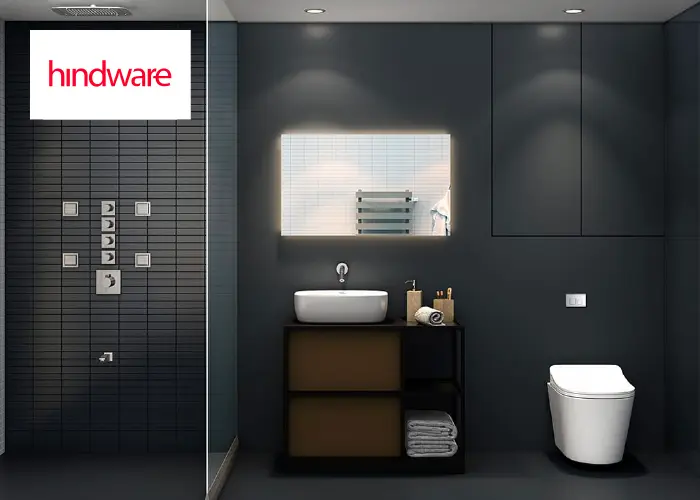Leading sanitaryware brands are investing in 3D visualizers to meet the evolving demands of today’s shoppers.
Understanding The Consumer Behaviour
Understanding the consumer behaviour is key to comprehending why 3D visualizers have become a pivotal tool for these brands.
1. Consumer Desire for Personalization:
Behavioural Insight: Modern consumers, empowered by an array of choices, seek products that align with their individual tastes and preferences. They are drawn to brands that understand and cater to their desire for unique, personalized experiences.
Link to 3D Visualizers: The configurability feature of 3D visualizers resonates with this consumer behaviour. Shoppers can personalize their sanitaryware products, experimenting with different styles, colours, and configurations. The visual representation of these choices adds a layer of tangibility, allowing consumers to see exactly how their personalized selections will fit into their living spaces.
2. Rising Expectations for Seamless Online Experiences:
Behavioural Insight: Consumers in the digital age expect a seamless online experience that mirrors or even surpasses the convenience of in-store shopping. They desire the ability to explore products thoroughly and make informed decisions from the comfort of their homes.
Link to 3D Visualizers: The immersive exploration feature of 3D visualizers addresses this expectation. Consumers can take virtual tours of stores, mimicking the in-store experience. This satisfies the consumer’s need for a thorough and engaging exploration of products, all accessible from the convenience of their devices.
3. Pre-Purchase Confidence through Visual Validation:
Behavioural Insight: Modern consumers often hesitate to make significant purchases online due to uncertainty about the appearance and functionality of the product in their own spaces. They seek reassurance and visual validation before committing to a purchase.
Link to 3D Visualizers: The realistic rendering capabilities of 3D visualizers directly address this concern. Consumers can see high-quality, lifelike representations of sanitaryware products in their own homes. This visual confirmation boosts their confidence in the product’s aesthetics and suitability, leading to a higher likelihood of completing the purchase.
4. Interactive Decision-Making Preferences:
Behavioural Insight: Consumers increasingly value interactive decision-making processes. They appreciate platforms that allow them to actively participate in the creation of their ideal products, fostering a sense of ownership in the purchasing journey.
Link to 3D Visualizers: The collaborative features of 3D visualizers facilitate this interactive decision-making process. Consumers can directly engage with the platform, configure products according to their preferences, and collaborate with brand representatives in real-time. This not only streamlines the decision-making process but also enhances the overall customer experience.
The ‘Experience’ Economy
Customers, now more than ever, seek experiences that go beyond mundane product descriptions and static images. This shift in consumer behaviour has given rise to what is often termed the “Experience Economy.”
The Craving for Immersive Experiences
Picture this: A customer embarking on a journey to revamp their bathroom, seeking not just a functional product but an entire experience. They want to envision how a sleek faucet complements the aesthetics of their modern bathroom or how a luxurious bathtub transforms their relaxation space. In this era of experiential consumption, customers crave more than just information; they long for an immersive understanding of the product within the context of their own lives.
Beyond Static Images: Enter 3D Visualizers
This is where 3D visualizers step in to meet the rising demand for immersive experiences. Unlike static images that provide limited perspectives, 3D visualizers offer a dynamic and interactive showcase of sanitaryware products. Customers can virtually place items in their intended environments, exploring the design, colour, and functionality in real-time.
Lifelike Representations for Informed Decisions
Imagine a potential customer using a 3D visualizer to explore how a modern sink fits seamlessly into their contemporary kitchen or visualizing the impact of a uniquely designed tub in their bathroom space. The ability to provide a lifelike representation of products in various settings empowers customers to make informed decisions. They can assess not only the visual appeal but also the harmony of the chosen sanitaryware within their own living spaces.
Creating a Personalized Preview
3D visualizers go beyond generic displays by offering customers the opportunity to personalize their experience. With just a few clicks, users can experiment with different finishes, colours, and styles, tailoring products to suit their individual preferences. This level of customization not only enhances the overall customer journey but also increases the likelihood of satisfaction post-purchase.
Bridging the Gap Between Online and Offline Shopping
For sanitaryware brands, the challenge lies in bridging the gap between the online and offline shopping experience. 3D visualizers act as a powerful bridge, providing an online platform for customers to virtually interact with products in a way that mimics the in-store experience. This seamless integration addresses the limitations of traditional showrooms, enabling customers to explore and engage with products from the comfort of their homes.
Current Trends In 3D Visualizers:
- Mobile Accessibility: With the increasing use of smartphones and tablets, brands are optimizing their 3D visualizers for mobile accessibility, ensuring that users can explore and customize products on the go.
- Integration with websites: Seamless integration with websites allows customers to transition from product visualization to purchase seamlessly. This trend aligns with the growing preference for online shopping and enhances the overall user experience.
- Virtual Avatars: The digital avatar acts as an assistant, offering contextual information, answering questions, providing informative descriptions and highlighting key product details.
Examples Of Leading Sanitaryware Brands Investing In 3D Visualizers
- DaveAI has introduced 3D visualizer for Hindware, a renowned name in high-end sanitaryware. This launch sets a new benchmark for virtual showroom interactions, offering Hindware customers an unmatched level of realism and engagement. This innovation allows users to immerse themselves in a visually stunning virtual environment, where each product intricacy is recreated with remarkable precision and lifelike accuracy.

2. One of the industry pioneers, Kohler, has embraced 3D visualizers to create a virtual experience for customers. Their online platform allows users to explore various bathroom designs, experiment with different product combinations, and visualize the end result in a 3D space. This not only enhances customer engagement but also empowers them to make informed decisions from the comfort of their homes.
3. DaveAI has introduced an innovative 3D visualizer for Jaquar, powered by a cutting-edge digital avatar. This breakthrough technology offers users a captivating and immersive experience, allowing them to explore Jaquar’s products in a dynamic and lifelike 3D environment. The digital avatar guides users through a virtual showroom, providing detailed insights and interactive demonstrations of various Jaquar offerings.

4. Duravit has integrated 3D configurators on its website, enabling customers to customize products according to their preferences and visualize the end result. This interactive approach has proven effective in engaging customers and streamlining the decision-making process.
Impact Of 3D Visualizers On Sales
The integration of 3D visualizers in the sales strategy of businesses, particularly in industries like sanitaryware, has demonstrated a significant and positive impact. Here’s a breakdown of the key ways in which 3D visualizers influence and enhance the sales process:
1. Increased Engagement and Conversion Rates:
- Behavioral Engagement: 3D visualizers captivate and maintain customer attention through immersive and interactive experiences. Customers spend more time exploring products in a virtual environment.
- Conversion Rates: The more engaged and confident customers feel, the higher the likelihood of conversion. 3D visualizers, by providing a realistic preview of products, contribute to higher conversion rates as customers can make informed decisions.
2. Reduced Product Returns and Increased Customer Satisfaction:
- Visual Validation: 3D visualizers allow customers to visualize and personalize products in real-time. This visual confirmation significantly reduces the chances of dissatisfaction upon product delivery.
- Customization Confidence: Customers who use 3D visualizers to customize products are more likely to be satisfied with their choices, leading to fewer returns and exchanges.
3. Streamlined Decision-Making Process:
- Efficient Exploration: The immersive nature of 3D visualizers provides customers with a comprehensive understanding of product offerings, streamlining the exploration process.
- Real-time Configuration: Customers can make configuration decisions on the spot, eliminating the need for extended decision-making periods. This agility in decision-making contributes to quicker sales cycles.
4. Competitive Differentiation:
- Brand Distinction: Businesses that adopt 3D visualizers stand out in a competitive market. The ability to offer a unique and engaging online experience distinguishes a brand and attracts customers seeking innovative and modern shopping experiences.
- Technological Leadership: Embracing advanced technologies like 3D visualizers positions a brand as forward-thinking and technologically adept, enhancing its appeal to tech-savvy consumers.
5. Enhanced Customer Confidence:
- Realistic Representations: 3D visualizers offer highly realistic renderings of products, giving customers a true-to-life preview of what they are purchasing.
- Visual Communication: The visual medium is a powerful communication tool. 3D visualizers effectively communicate product features, benefits, and customization options, fostering customer confidence in their buying decisions.
6. Global Reach and Accessibility:
- Breaking Geographical Barriers: Virtual platforms powered by 3D visualizers enable brands to reach a global audience without the constraints of physical locations.
- Accessible Anytime, Anywhere: Customers can engage with 3D visualizers from the comfort of their homes, at any time. This accessibility increases the touchpoints for potential customers, leading to expanded market reach.
7. Facilitated Upselling and Cross-Selling:
- Visual Product Bundling: 3D visualizers make it easier to showcase complementary products or upsell additional features. Customers can see how additional items integrate with their chosen products, encouraging them to consider more comprehensive purchases.
The Future Of Retail Is Virtual
The future of retail is virtual, where physical and digital worlds seamlessly converge to redefine the shopping experience. As consumers increasingly embrace online interactions, virtual platforms are becoming the new frontier leading to sanitaryware brands investing in 3D visualizers. These platforms not only replicate the in-store experience with immersive tours and product customization but go beyond, breaking geographical barriers and enabling brands to connect with a global audience. The fusion of real-time collaboration, personalized exploration, and visual validation is reshaping consumer expectations, propelling retail into a digital era where convenience and innovation converge to create an engaging shopping landscape.



